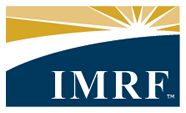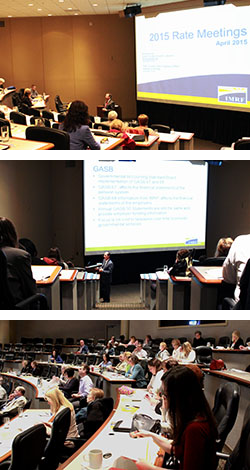The 2015 IMRF Employer Rate Meetings wrapped up on Wednesday, April 29, with good news for IMRF Employers participating in the fund. As a part of the rate meetings, IMRF Executive Director Louis W. Kosiba along with IMRF Chief Financial Officer Mark Nannini traveled the state to explain how strong investment returns and lowers costs associated with the Tier 2 benefit structure are lowering costs for local units of government and taxpayers.
2015 Rate Meetings by the Numbers

Rate Meeting Webinar
On May 5, 2015, IMRF presented a webinar to discuss employer rates and contributions. IMRF Executive Director Louis Kosiba and Chief Financial Officer Mark Nannini used the event to review the impact of year-end financial and actuarial data on IMRF. Over 200 participants registered for the webinar representing employers from across the state.
Reactions to 2015 Rate Meetings
"This meeting definitely adds value to my organization. The more we are aware about how IMRF is operating and where its focus lies, the better off we will be as an organization."
Assistant Superintendent of Finance, Arbor School District 145
"I have been to these presentations. Lou & Mark are good presenters. They make the high-level information very easy to understand. I plan to share the information I gathered at my next board meeting."
Administrative Services Director, Downers Grove Sanitary District
"Information pertaining to GASB68 is very helpful. I talk with our auditors all the time. Gaining this information at the presentation will give me a perspective. I definitely plan to share the information with my director."
Administrative Office Coordinator, Indian Prairie Public Library
Rate Meeting Webinar Questions and Answers
On May 5, 2015, IMRF presented a webinar to discuss employer rates and contributions. Noted below is a transcript of the questions posted at the end of the discussion and the detailed answers from the presenters, IMRF Executive Director Louis Kosiba and Chief Financial Officer Mark Nannini:
Q. Glen Ellyn Park District: The assumption for wage inflation changing from 4.0% to 3.5%; is this different than the Annual Statement employees get that shows the projected monthly pension assumes a 3% wage increase?
A. Louis W. Kosiba: Yes, and if you go back to slide 12, you will see wage and price increases are different.
Q. Multiple Queries: Where can we find a copy of these slides?
A. Louis W. Kosiba: They will be on our website. We're also going to make a copy of this presentation that will be available for viewing the week of May 11, 2015. Both the slides and the presentation will be available on IMRF's website. Questions received during and after the presentation will be answered and posted to the site as well.
Q. Comm. Cons. School District 59: The Employer GASB 68 application ... who should complete that?
A. Mark Nannini: Your Authorized Agent can complete that or anyone ... either a Finance Director, Manager ... you feel comfortable with as an organization.
Q. Glen Ellyn Park District: Is there any thought to adjusting the Member Statements that assume the 3% increase since members have been realizing a 0%-2% increase the past 7 years or so?
A. Louis W. Kosiba: First of all, the Member Statement just reflects what a member has contributed over the last year and it identifies salary, it identifies contributions, it talks about death benefits. So 3% really is not part of that Member Statement. It reflects what happened with that individual. It also provides pension estimates and the cost in the private sector to buy an annuity to replicate the IMRF benefit.
Q. Quincy Park District: Is the 3.5% projected wage increase realistic?
A. Louis W. Kosiba: Excellent question! This is a long-term number (assumption). It may not necessarily be the same for this year or next year, but our actuaries feel that over the long term, it is realistic. The number was 4% and it has gone down to 3.5%. This number reflects any promotions an individual gets over their working career. It also needs to reflect what happens in terms of any payouts an individual will receive at the end of their career. So the projection is an average that we use. When your employees retire, the cost is going to be what the cost is. And so you're not necessarily overcharged.
Q. Village of Deerfield: Lou, can you explain how interest is calculated under the Voluntary Additional program?
A. Louis W. Kosiba: Yes! IMRF members are eligible to contribute up to 10% of their pay to this program. It has to be deducted from their wages. It is sent to IMRF, and we will post 7.5% interest to contributions in the program. Interest is always calculated on the opening balance. So, for example, if you entered the program in 2015, you have zero dollars in the program on January 1 when we look at the opening balance. At the end of the year, let's say you put $1,000 in. You're not going to get any interest on that money until the end of 2016. In 2016, your opening balance is $1,000; you're going to get 7.5% interest on that. Anything you contribute in 2016 will not be used, and you will not receive interest on that until it appears in the opening balance in 2017 and interest is posted at the end of the year. So it's somewhat archaic in the way that it is posted. On the other hand, 7.5% is very good by today's standards.
Q. Palatine Public Library: Will the new mortality tables continue to increase the contribution rate over the next few years until they are fully integrated?
A. Louis W. Kosiba: The new mortality tables were fully integrated into future employer contribution rates. Future rates will be higher than they would have been if the new tables were not adopted. But due to undistributed investment gains, employer rates will trend downward, on average, if IMRF continues to earn 7.5% on investments.
Q. Village of Sauk Village: Can you be more specific about term smoothing?
A. Louis W. Kosiba: So what we're talking about with term smoothing is each year, IMRF either makes money or loses money on its investments. And when we go to calculate employer contribution rates, only one-fifth of that gain or loss is used in calculating those rates. So, for example, the gain that we had in 2014, one-fifth of it was used to calculate the 2016 rates and one-fifth will be used in 2017, 2018, 2019, and 2020. So there is the five-fifth. If you keep going back in time, now, what happened with the 2013 return? Those were spectacular; we earned 20%. One-fifth of the 2013 earnings, or gains, were used in calculating the 2015 rates and one-fifth was used in the 2016 rates, and then it will be used up in 2017, 2018, and 2019. So it's always five years going forward. There's always the current year and then four back years. Eventually years drop off and you add new years.


